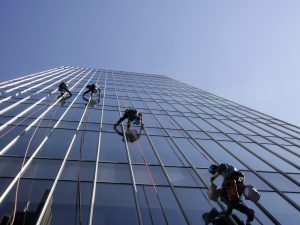Is it possible for scaffold erectors to comply with the Federal Occupational Safety and Health Administration (OSHA) standards for both fall protection and scaffold erection? I think not. Here’s why.
Federal OSHA requires that scaffold erectors use safe personal fall arrest protection, if it is feasible to do so, as determined by a competent person. This is what happens in a perfect world. I say a perfect world because, in the real world, expectations don’t necessarily agree with the standards. OSHA compliance officers, company safety managers, scaffold erectors, and yes, consultants, typically have very different ideas about erector fall protection and the applicability of the fall protection and scaffold standards. The confusion begins with the strength requirements specified in the OSHA Fall Protection Standards, Subpart M. In addition to other requirements, Subpart M specifies the minimum standards for the use of fall protection equipment. The standards specify that all systems, designed or undesigned, must limit the force on the body to 1,800 pounds (ouch) and the freefall distance to 6 feet. Additionally, undesigned systems require that the anchor strength must be at least 5,000 pounds. That is a lot of pounds. The scaffold has to be real special to handle that kind of load and of course, most scaffolds cannot handle that much force on its components. (It is still a mystery as to how anyone would know that an anchor could hold 5,000 pounds if it is not designed, or at least analyzed!)
Unfortunately, lots of folks think, or at least assume, that most scaffolds can support a 5,000 pound load. Typically, the scaffold erector gets forced into “tying off” to the scaffold because a safety officer requires it. Never mind the scaffold can’t support the 5,000 pound load. For the safety officer, this isn’t normally important as long as the erector is tied to something so it looks good. Assuming the erector doesn’t fall, anyone observing the situation could conclude that tying to the scaffold is a good thing and assume that the erector’s actions are not only safe, but also are in compliance with the standards. Therein lies the problem. By tying off to the scaffold, the erector is probably violating the fall protection standards since the scaffold cannot handle the 5,000 pound anchor load. Should he be cited? Maybe we should ask if he is safe. Assuming that the scaffold is properly built and in accordance with good construction practice, it just might be able to support him if he falls.
How can this be, you might ask? If the erector is wearing a shock-absorbing lanyard, and his freefall is less than 6 feet, the force on the scaffold will be approximately 900 pounds. (Before all you fall protection people and engineers jump all over me for this seemingly gross assumption, please note that I said a “properly built” scaffold.) Nine hundred pounds is a lot less than 5,000 pounds. Unfortunately the erector is not in compliance with the standards because a qualified person didn’t design the fall protection anchor. According to the standards, an undesigned anchor must support a falling load of 5,000 pounds. Since the erector appears to be out of compliance, should he be cited?
But wait a minute. Where’s the hazard? If the erector is exerting a force of 900 pounds on the scaffold, and the scaffold can support that load, what’s the problem? None, except the anchor wasn’t designed and consequently the erector is in “technical” violation of the standards. If the scaffold doesn’t collapse, and the erector is not in harm’s way, can this be a bad thing? I doubt it. This however does bring us to the issue at hand; it’s time to waive certain fall protection standards for erectors.
Rather than continue this argument that scaffolds cannot be used as anchors because they don’t comply with the fall protection standards, it is time to recognize that scaffold erectors have special requirements that are not met with the existing standards. If we are to pursue the idea that we need to provide additional protection for erectors, beyond better training and skills, then the standards must be modified to reflect that approach. If contractors, safety officers, consultants, and compliance officers continue to insist that erectors tie to scaffolding, then its time to grant a permanent variance to the fall protection standards. There is no way that using scaffolding as undesigned anchors will ever be compatible with the fall protection standards, as they are written.
I suggest that OSHA work with the scaffold industry to enforce the regulations that are critical to the elimination of hazards. The existing standards specify that the competent person determines the fall protection for erectors. This would include leaving the decision about fall protection with the competent person and waiving certain fall protection standards. Specific training, for erectors, compliance, and safety workers, would be necessary to ensure that only the applicable standards are enforced. Of course, there will be an increased responsibility for the competent person to ensure that the best protection is provided for the erectors. But then, there is nothing wrong with this. Its time that erectors recognize, while they may be special, are not above the standards. In turn, OSHA needs to recognize that the work of the scaffold erector is neither correctly addressed by the present standards nor correctly enforced by compliance officers.
Until the standards are modified to reflect current safe practices, those individuals charged with safety must recognize that compliance with one standard may result in the violation of other standards. Furthermore, safety officers and erectors must recognize the application of one standard doesn’t permit the violation of other standards without repercussions. That is the dilemma. It’s time to do something about it. Do you agree?
Note: This article consistently referred to erectors in the masculine: “he/him”. Why are there no female scaffold erectors?












